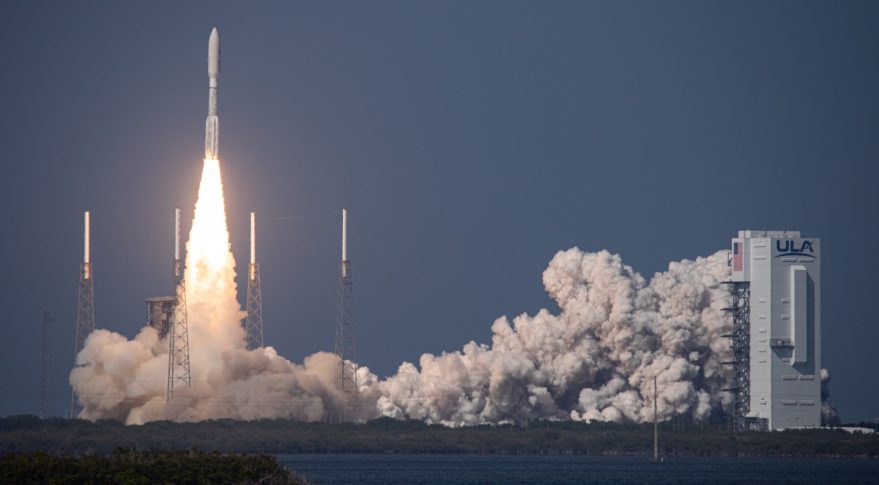
WASHINGTON — The U.S. military over decades has built extensive infrastructure to move troops and equipment around the world. It may now need to start thinking about investing in foundation technologies to support future activities in space, said Lt. Gen. John Shaw, deputy commander of U.S. Space Command.
“As we move forward, we’re going to want to find ways to be more mobile in space,” Shaw said Feb. 17 at a Washington Space Business Roundtable virtual event.
The U.S. military currently has no plans to deploy troops to space but should consider investments in “mobility and logistics” to prepare for the future, said Shaw.
“If we don’t address those requirements, that would be shutting a door that we need to keep open,” he said.
Mobility and logistics are a “strategic capability” that the military has in the maritime, air and land domains, and should eventually have in space, Shaw said.
The space industry is developing servicing robots, maneuvering satellites, in-space transport vehicles and other technologies the military would be able to use. Shaw said U.S. Space Command will leverage commercial systems but “we will also have our own, and we will need the other combatant commands to support us.”
As a unified combatant command, U.S. Space Command can influence what the Pentagon buys through the so-called “requirements process.” For future operations, Shaw said, the military could “preposition logistics in space. to replenish space assets rapidly from the Earth’s surface or elsewhere in orbit.”
“When it comes to mobility and logistics, we need to look at the space domain the same way we look at other domains,” he said. “We will continue to develop requirements along those lines. I cannot imagine operations in space in the decades and centuries to come without mobility and logistics underpinning all of this, like they have in the other domains.”
Space Force tech development plans
Space mobility and logistics will be part of a $90 million research and development program that Congress directed in the U.S. Space Force 2021 budget.
The Space and Missile Systems Center Launch Enterprise issued a request for information Nov. 10 asking companies about their planned investments in space mobility and logistics. In a Feb. 17 update, the Space Force said it will start a program for “expanded space access, mobility and logistics needs to further strengthen U.S. space dominance.”
The Space and Missile Systems Center’s Space Enterprise Consortium works with many non-traditional aerospace companies that are developing mobility and logistics systems. SMC said the consortium will sign agreements with companies to “accelerate the development of transformational space access, mobility, and logistics prototypes.”
Original Text (This is the original text for your reference.)

WASHINGTON — The U.S. military over decades has built extensive infrastructure to move troops and equipment around the world. It may now need to start thinking about investing in foundation technologies to support future activities in space, said Lt. Gen. John Shaw, deputy commander of U.S. Space Command.
“As we move forward, we’re going to want to find ways to be more mobile in space,” Shaw said Feb. 17 at a Washington Space Business Roundtable virtual event.
The U.S. military currently has no plans to deploy troops to space but should consider investments in “mobility and logistics” to prepare for the future, said Shaw.
“If we don’t address those requirements, that would be shutting a door that we need to keep open,” he said.
Mobility and logistics are a “strategic capability” that the military has in the maritime, air and land domains, and should eventually have in space, Shaw said.
The space industry is developing servicing robots, maneuvering satellites, in-space transport vehicles and other technologies the military would be able to use. Shaw said U.S. Space Command will leverage commercial systems but “we will also have our own, and we will need the other combatant commands to support us.”
As a unified combatant command, U.S. Space Command can influence what the Pentagon buys through the so-called “requirements process.” For future operations, Shaw said, the military could “preposition logistics in space. to replenish space assets rapidly from the Earth’s surface or elsewhere in orbit.”
“When it comes to mobility and logistics, we need to look at the space domain the same way we look at other domains,” he said. “We will continue to develop requirements along those lines. I cannot imagine operations in space in the decades and centuries to come without mobility and logistics underpinning all of this, like they have in the other domains.”
Space Force tech development plans
Space mobility and logistics will be part of a $90 million research and development program that Congress directed in the U.S. Space Force 2021 budget.
The Space and Missile Systems Center Launch Enterprise issued a request for information Nov. 10 asking companies about their planned investments in space mobility and logistics. In a Feb. 17 update, the Space Force said it will start a program for “expanded space access, mobility and logistics needs to further strengthen U.S. space dominance.”
The Space and Missile Systems Center’s Space Enterprise Consortium works with many non-traditional aerospace companies that are developing mobility and logistics systems. SMC said the consortium will sign agreements with companies to “accelerate the development of transformational space access, mobility, and logistics prototypes.”









 User Center
User Center My Training Class
My Training Class Feedback
Feedback












Comments
Something to say?
Log in or Sign up for free